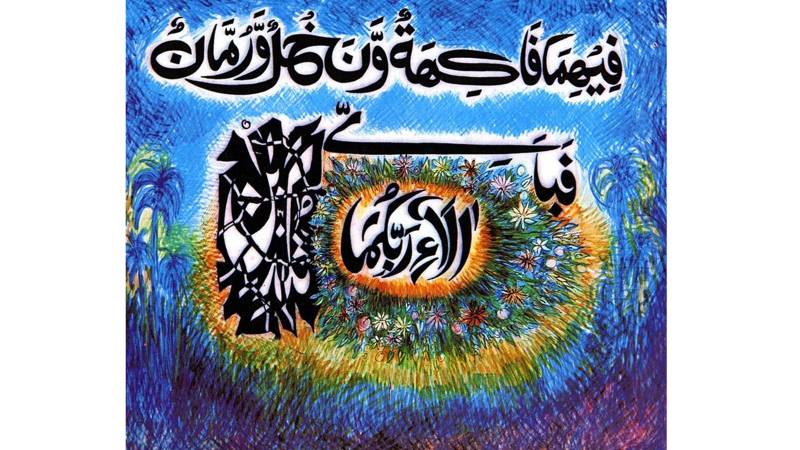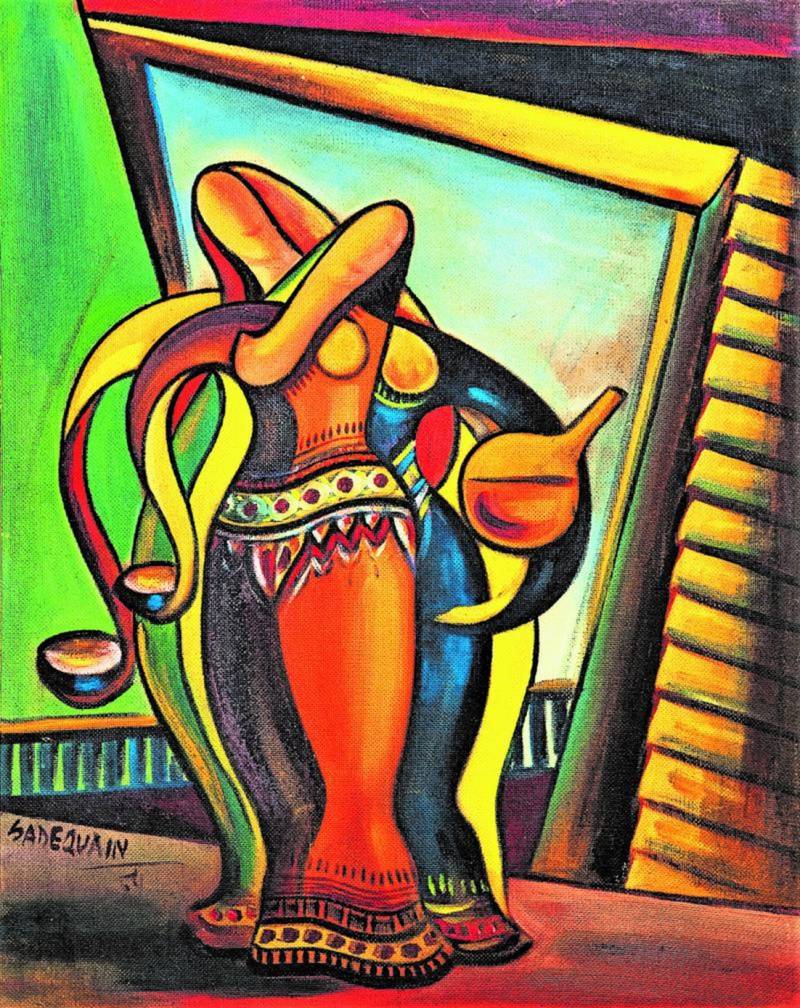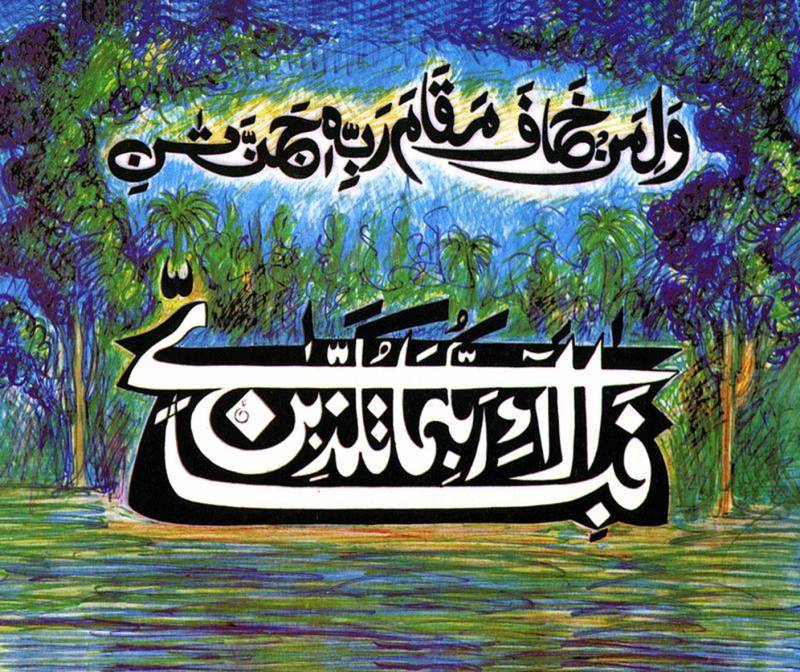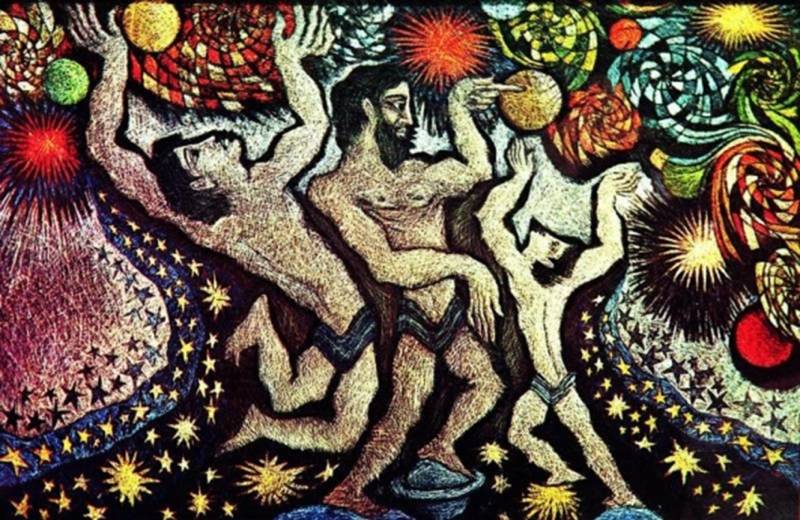
The present essay has been written in response to the article entitled “Remembering Pakistani Artist Sadequain: My Uncle Who Spoke Up For Others,” penned by Myrna Ayad, and published, as a part of a series called “Remembering the Artist,” in the Weekend section of The National on 12 August 2022, attempting to express memories of Mr Salman Ahmad, founder of the Sadequain Foundation – San Diego, California (USA), associated with his uncle Syed Sadequain Ahmad Naqvi (1930 Amroha-1987 Karachi) – the eminent painter and calligrapher who died 37 years ago on 10 February.
He begins his account with the pangs of India’s partition and how the painter’s family consisting of 17 souls [in reality 7] had, in the year 1948, migrated to the recently-carved country called Pakistan and settled there. Their story is similar to that of other migrants who suffered the brunt of division and were hoodwinked to reside in an alien land with the least possible resources. The narrator, in the beginning, describes events such as the construction of his father’s house (Sibtain Manzil – named after Sadequain’s father) in Karachi, the populace configuration of Nazimabad which later became a hub of the intelligentsia, the constant and unexpected arrival of people at home to meet his uncle and receive paintings as gifts, and the story of a rickshaw driver who was generously helped by the artist in mid-1950s to get a rickshaw, among others. With such information and style, the relater instantly tries to draw the attention of readers towards his memoir – if they are appropriate to be called so, for none of the said occasions connect Salman with Sadequain.

Speaking about Sadequain’s early career, his nephew states that in the early 1940s [in fact late 1940s] he joined his brother Syed Kazmain Ahmad Naqvi at All India Radio and was employed there as a calligrapher-copyist and post-migration he worked as a college teacher and at Radio Pakistan, before devoting himself entirely to his callings – painting, poetry, and calligraphy. These may come as fresh information for the inexperienced followers of the painter, but, wait; certain breaches in the narrative must be brought to notice to provide a transparent depiction. At the same time, critics must scrutinize the veracity of the information provided by the raconteur as misleading information, if any, will give rise to myths and legends.
After passing the Intermediate of Arts, Sadequain joined Imam-ul-Madaris (Amroha), an institution established by his ancestors, as a teacher of drawing, forming a preliminary part of his profession, whose reference should have been added to the said recollection.
It is an acknowledged fact that any memoir is a biography written from personal memories of the chronicler, but in the present instance, the settings don’t allow one to call Salman’s account a memoir for he barely spent adulthood with his uncle. He was 13 years old (b. 15 December 1946) in 1960 when Sadequain left for Paris where he spent almost 7 crucial years of his life immersing himself in painting; and by the time he returned to Karachi in 1967, Salman had relocated to the United States of America. However, in between these 7 years, Sadequain visited Karachi for short intervals but they were not adequate for his nephew to accumulate his cache of vast memory as he claims and therefore his memoir, if any, lacks depth and nuanced evidence. Besides, between 1967 and 1987 Salman visited Karachi on 4-5 occasions but he lost the opportunity to meet Sadequain as by 1972 he had shifted his base to Islamabad and Lahore. What is even more bewildering is that he couldn’t attend the funeral of his beloved uncle in 1987, and neither could he, until now, pay a visit to his grave. Being luckless, he couldn’t attend the last rites of his grandmother (d. 1969), father (d. 1972), grandfather (d. 1975), sister (d. 1981), and mother (d. 1995) either; and, thus, the fate deprived him of being part of critical family-events forming everlasting memories.

One of the startling revelations made by the storyteller pertains to his discovery of more than 500 paintings of Sadequain (lying abandoned and stored in attics, basements, and storage facilities) in 2011 in Paris; but this disclosure raises grave questions such as: 1. How could an artist illustrate such a large body of works in 7 years besides his round-the-clock engagement as a commissioned painter in Paris and visits to, and numerous exhibitions in, Pakistan, United States of America, England, and Switzerland?; 2. How could these survive for 44 years (since 1967) lying abandoned?; 3. How could the owner of the place remain unaware of such precious paintings for more than 4 decades?; 4. How did the narrator come to know about these images?; 5. Where are these placed now?; 6. Why didn’t Salman publish an inclusive catalogue of these illustrations?; 7. Why didn’t the discoverer discuss these paintings in any of his 25 published books?; 8. How did the utterer manage to get hold of these?; 9. Why didn’t Sadequain ever speak of these in his lifetime?; 10. Why didn’t any newspaper, national or international, or magazine report this thrilling find?; and 11. Why no specimen of the said collection was added to the article under debate? Such queries cast suspicion over the credibility of the alleged discovery and seek answers from the relater; otherwise, his declaration will be treated as a sheer claim, providing currency to traditions.
Later, unexpectedly, between 17 June 2014 and 18 July 2015, the Aicon Gallery, New York, in collaboration with Salman organized an art show entitled The Lost Exhibition which included paintings such as Acrobats (Blue) 1966-67, Walking in Paris, and Dancing in Paris, among others, that Sadequain had allegedly left behind in Paris before leaving the city. This show also included images namely Sun on the City, Sunrise to Sunset, Sacrifice, Women with Lotus and Mirror, Women with Vanity Mirror, Five Women, Fifteen Heads, Headless with Self-portrait, and Surah-E-Rahman. When the gallery came to know that all these pictures on display were fabricated and embossed with the fraudulent signature of the painter it discontinued the fair and severed its ties with the collaborator.
Further scrutiny of the chronicle reveals that barring 1-2 episodes, it is not a memoir per se, but an arrangement of a few events taking place in Sadequain’s life whose particulars can be effortlessly found in his self-published biodata. Besides, while weaving family background the memoirist forgets to offer basic facts such as names of his father (Kazmain Ahmad – Director of News of Pakistan Radio, and later Joint Secretary with the Information Ministry), his second uncle (Syed Hasnain Naqvi), and his grandfather (Syed Sibtain Ahmad) – whose Sibtain Manzil, constructed by his sons, witnessed the creation of some of the finest specimens by the artist such as the Last Supper, Surah-E-Rahman, illustrations of Mirza Ghalib, and Rubaiyyat-E-Sadequain, inter alia. The readers would have loved to know Salman’s views and observations about Sadequain’s murals – The Saga of Labour and Quest for Knowledge – that the former has described in his recollection. If he had witnessed their creation he would have described the stages of their production, but sadly the reality is otherwise. Further, he fails to name the depiction (the Last Supper – an abstract of an eponymous work by Leonardo da Vinci) that won the painter an award at the second Biennale de Paris (Sept-Oct 1961) paving the path for his almost 7-year-long stay in France with a few breaks. His narrative also reflects as if the said Biennale was held in 1960 and sponsored by the French Committee of the International Association of Plastic Arts (the inviter). His declaration is further erroneous when he states that the Biennale granted Sadequain a scholarship leading to successful exhibitions in France, the UK, and the USA; however, on the contrary, the fact is that after winning the coveted admiration his popularity grew by leaps and bounds, consequently garnering him numerous art-shows, projects, and assignments including illustrations of Albert Camus’ L’Etranger (the noble prize awarded novel) in February 1964.

Likewise, Salman’s assertion about the use of cacti (a metaphorical symbol of humanity’s resistance and resilience) in Sadequain’s works and his seclusion to Gadani, a seaside town, is yet again not a slice of his memory, but an occasion recorded by the muralist himself who, while speaking to Rehana Hakeem of the Herald (Pakistan) in July 1965, says, “I was once upon a time living in cactus land. There were cacti all around me. To my east, west, and north there were cacti. And to my south, there was just the Arabian Sea.
Living with cacti, I too became a cactus. I was in the cactus and the cactus was in me. Cactus grows in the most hostile climates – sand, heat, salt, no rain. It doesn’t grow in fertile soil. Yet it grows majestically as if its thorny branches are trying to catch the clouds. To me, it symbolizes the triumph of life over the environment. Once upon a time, I used to identify it with my own self. Then I started identifying it with the whole community.”
When compared with the aforesaid interview one finds that the narrator botches up the years and circumstances concerning Sadequain’s stay in Gadani by generalizing that in the late 1950s and early 1960s, he secluded himself to the coastal town, however, the fact being that he was invited there in 1959 for a few months by Mr. Suleiman, a Collector of Customs, who offered him a suitable housing at a hilltop commanding a splendid sea-view, inspiring him to observe surroundings and consequently use cactus profusely in his paintings.
Therefore, it can be resolved that whatever the storyteller has articulated in his so-called recollection is anything but a memoir, and one should be careful enough to validate specifics with other sources before placing them into the public domain. Finally, to the astonishment of readers, it is essential to indicate that even the images used in the article are as deceitful as the remembrance is.

